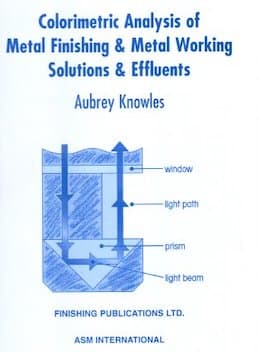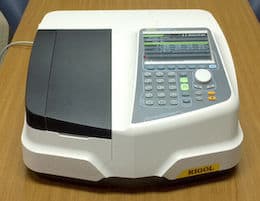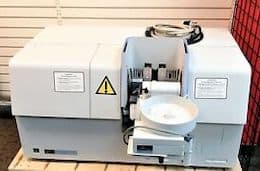
Curated with aloha by
Ted Mooney, P.E. RET

The authoritative public forum
for Metal Finishing 1989-2025

-----
Zinc Cobalt alloy plating solution: analyze cobalt content
Q. Sir,
We have a plating shop in our company. Currently we are doing Zinc-Cobalt alloy plating . We want a procedure (other than atomic absorption method) to determine/analyse the cobalt present in the fresh as well as working solution. We do not know in which complex form cobalt is present.
plating shop - Chennai, Tamil Nadu, India
2004
A. Cobalt produces a visible spectrum, peaking at either ca. 500nm for the octahedral (Co[H2O]6)^^2+ or 710nm for the tetrahedral [CoCl4]^^2- complex. You can therefore monitor the cobalt concentration by using either or both of these wavelengths in a visible spectrophotometer ⇦ this on eBay or Amazon [affil links] . You may need to determine which is the better complex structure to monitor as it will depend on the electrolyte chemistry.

Trevor Crichton
R&D practical scientist
Chesham, Bucks, UK
Q. Sir,
Thank you for your response. The answer is not enough for us. We want to analyse for Cobalt of the order of 100 ppm in a Zn-Co alkaline plating bath with Zinc around 1% concentration. It is required to isolate Cobalt from Zinc and establish suitable calorimetric reagent for Cobalt.
Plating - Chennai, Tamil Nadu, India
A. To analyse that sort of level you need to use either AA or ICP. If these are not available, you can try titrating it using either cyanide or EDTA methods - both are available in any good WC plating book. I think these limits are too low for accurate titrating unless you are really good at it, as end points are not the easiest to see. You may want to try concentrating the sample solutions by evaporation.

Trevor Crichton
R&D practical scientist
Chesham, Bucks, UK
by Aubrey Knowles

on AbeBooks
or Amazon
(affil links)
A. Aubrey Knowles' "Colorimetric Analysis of Metal Finishing & Metal Working Solutions & Effluents" ⇨
describes 3 colorimetric tests for Co. If you don't have Fe, Cr, Cu, U, Bi or Ni in large amounts, the most straightforward method of the three (p. 53) is by forming a blue thiocyanate complex with ammonium thiocyanate
⇦ this on
eBay
or
Amazon [affil links]
; ammonium acetate, trisodium phosphate
⇦ this on
eBay
or
Amazon [affil links]
, tartaric acid
⇦ this on
eBay
or
Amazon [affil links] and hydroxylamine hydrochloride are used for buffering and to minimize interferences. The complex is extracted into an amyl alcohol - diethyl ether mixture. Colorimetry is done on the extract at 620 nm. If it works for you and you intend to use it a lot, note that it can be simplified considerably if you have a decently equipped lab.
- Yorktown Heights, New York
Q. How to do the analysis of zinc-cobalt solution and send me how to find the zinc metal, cobalt metal, chloride and boric acid?
Anil Kumarplating shop employe - Bangalore, Karnataka, India
May 30, 2011
A. Hi, Anil.
We appended your inquiry to a thread that discusses the cobalt analysis. Your vendor will have a "technical data sheet" for the process that explains how to control the other components that you mentioned. Good luck.
Regards,

Ted Mooney, P.E.
Striving to live Aloha
finishing.com - Pine Beach, New Jersey
Q, A, or Comment on THIS thread -or- Start a NEW Thread

